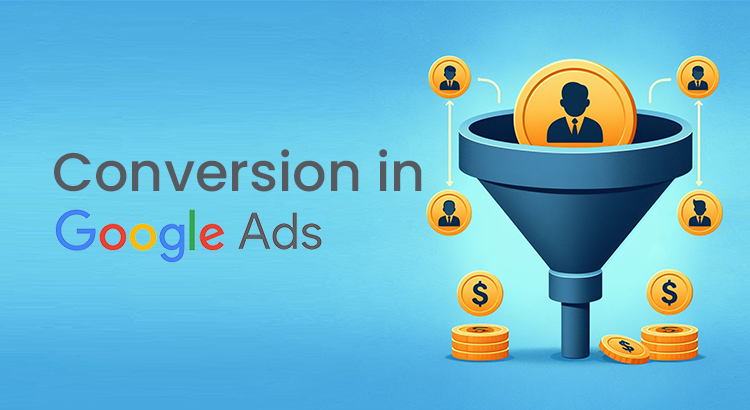Nowadays, businesses turn to Google Ads to maximize their reach and impact. One crucial metric in evaluating the success of these campaigns is the conversion rate. Conversion in Google Ads refers to a specific action that holds value for a business, such as a sale or lead generation.
Related Article: Conversion Rate Optimization: Turning Clicks into Customers for Small Businesses
Definition of Conversion in Google Ads
Conversion value, a crucial metric in Google Ads, encapsulates the monetary worth associated with a particular action on a website, such as a sale or lead acquisition. It is computed by dividing the total number of conversions by the overall interactions or clicks on an ad.
Understanding and refining conversion values empower businesses to fine-tune their marketing strategies, ensuring a more efficient use of resources and an improved ROI.
How to Improve Conversion Rate in Google Ads?
1. Optimize the Customer Journey
Ensure a seamless user experience from search to ad to landing page. Map out the customer journey, gather insights, and use data to identify touchpoints, pain points, and drop-off points. Aligning intent throughout enhances the overall conversion rate.
2. Consider Top-of-Funnel Offers
Recognize that users may need more time for decisions. Supplement landing pages with top or mid-funnel offers like ebooks to cater to information-seeking users, supporting buyer research and addressing varied purchasing mindsets.
3. Prioritize Keywords by Intent
Evaluate keyword intent and adjust strategy accordingly. Prioritize high-intent keywords, acknowledging their competitiveness. Regularly monitor the search terms report to add negative keywords, reducing irrelevant queries and improving the likelihood of user conversion.
4. Have Multiple Ad Copy Variations
Experiment with diverse ad copy variations to find the most effective language for each ad group.
Utilize Google’s Responsive search ads for flexibility in headlines and descriptions, allowing machine learning optimization over time. Eliminate underperforming variations to boost overall conversion rate.
5. Optimize Your Landing Pages
Enhance PPC landing page optimization by aligning copy and intent with ad copy and targeted keywords. Ensure clean design, ease of navigation, and appropriate information density based on user intent.
Tailor the landing page to provide assurance for significant decisions or streamline actions for straightforward offers.
Learn More: Landing Page Best Practices for High Conversion Rates
6. Choose the Right Bidding Strategies
Maximize performance by leveraging automated bid strategies such as Max Conversions, Target CPA, and TROAS.
Allow Google’s machine learning to align with bid strategy goals, selectively serving ads to users with a higher likelihood to convert within specified costs. Strategic bidding significantly influences both ad and landing page effectiveness.
What Is a Good Google Ads Conversion Rate?
The average conversion rate for Google Ads stands at 3.75%. To achieve a commendable conversion rate, aim for a figure higher than 5.31%. The top 25% of companies utilizing Google Ads boast an impressive conversion rate of 11.45%.
How to Setup Conversion Tracking in Google Ads?
Step 1: Sign in to Google Ads
Begin by signing in to your Google Ads account. Ensure that you have an active account as you’ll need it to set up and manage conversion tracking.
Step 2: Choose the Right Conversion Action
Navigate to the ‘Tools & Settings’ tab in the top right and click ‘Conversions.’ Evaluate your business goals and choose the most valuable action to track. Create a new conversion action or edit an existing one.
Step 3: Create a Conversion Action
Click the ‘plus’ button to create a conversion action. Opt for the appropriate type based on your goals (Website, App, Phone Calls, or Import). For on-site transactions, choose ‘Website.’
Step 4: Configure Conversion Action Settings
Name the conversion, select a category (Purchase/Sale, Sign-up, Lead, View of a key page, or Other), and set parameters like value, count, conversion window, and view-through conversion window according to your needs.
Step 5: Set Up the Conversion Tracking Tag
Choose how to set up the conversion tracking tag. Options include self-installation, emailing it to your webmaster, or using Google Tag Manager if configured. If you opt for self-installation, Google will provide a global site tag for you to add to your website.
Step 6: Save and Apply the Conversion Action
After installing the tag, save the conversion action. It will now appear on the Conversions page, ready to record data when users perform the tracked action.
Step 7: Monitor your Conversion Data
Regularly check the Conversion actions page to monitor your conversion activity. Analyze the data and optimize your ad campaigns based on your observations.
Keeping a close eye on conversion metrics ensures you can refine your strategies for better campaign performance and improved ROI.
Final Thoughts on Conversion in Google Ads
Understanding and improving the conversion rate in Google Ads is paramount for business success. By implementing the tips mentioned in this article, businesses can enhance their conversion rates and achieve a more effective ROI.


